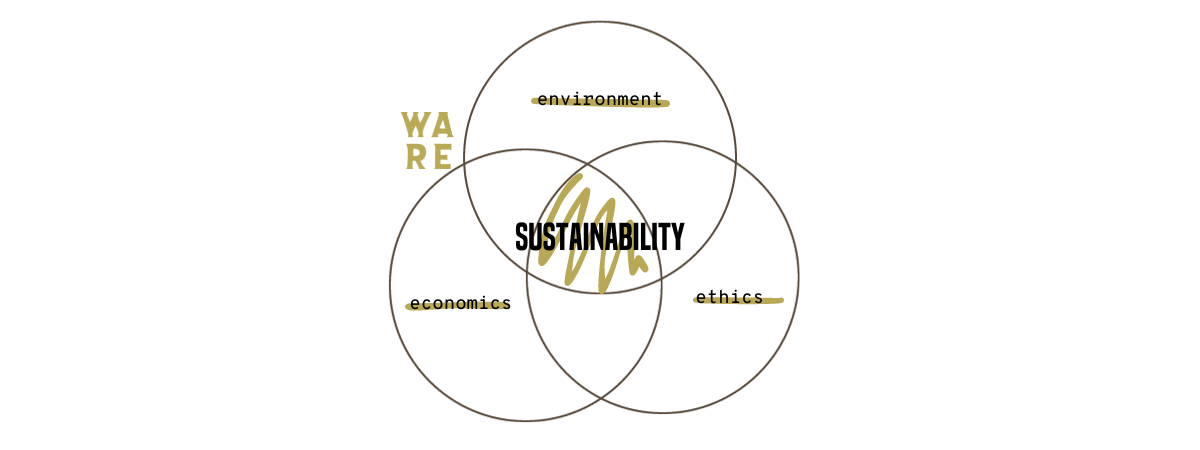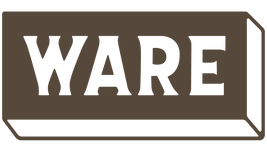
Sustainability 101
The following piece was written by Ware's founder, Gillie Roberts, for Asheville business journal, Capital at Play (no longer in circulation). It was originally published in 2019. Minor edits have been made by the author. The photography included in this post was not attached to the original publication.
For such a long word, “sustainable” seems to have found its way onto websites and advertisements from the service industry, to tech, to beauty products - reminding us all that no one pays by the letter for marketing materials anymore. Longer still is the conversation around what sustainability actually entails. [...]
Aside from being used in the context of maintaining some aforementioned action or status (e.g. financial sustainability or the sustainability of your new diet), “sustainable” most colloquially references environmental practices that have an eye to conservation and pollution minimization. However, international development (that’s the field of work related to the growth and evolution of societies around the world) takes a more comprehensive approach, establishing true sustainability as the portion of the Venn diagram where the following three undertakings overlap: environmental stewardship (inclusive of the animal kingdom), ethical treatment of human actors and their cultures, and responsible action wherein economies are affected at both micro and macro levels.
If that doesn’t seem to narrow it down much, you’re not alone in your confusion. Sustainability has rather nebulous roots. One of the earliest and most-quoted definitions of sustainable development is, “meeting the needs of the present without compromising the ability of future generations to meet their own needs,” from a 1987 UN report. Though poetic, that description offers little guidance for those of us looking to put action behind the underlying values.
While studying sustainable development, we used the “3 P’s” (planet, people, profit) or “3 E’s” (environment, ethics, economics) as simplified mnemonic devices to keep discussions organized. Any of the concept’s three pillars can easily be broken down into dozens of fields with experts whose work must continue in perpetuity in order to keep the larger community operating with the best and latest information. Not only is sustainability all-encompassing, it relies on sciences that are learning more as the world around us changes at an accelerating pace. In fact, sustainability has changed so much in the past five years alone, it’s not even always called by that name anymore.
Now that sustainability efforts include fighting the drastic and ever-worsening effects of climate change, the term “resilience” often replaces “sustainability,” as it considers a project’s ability to recover from extreme weather patterns or the need to restore an environment before productive efforts can begin. The real difference between the two is the starting point – sustainability efforts assume we are starting at zero, while resilience efforts start in the negative or prepare for its eventuality. I mostly tell you this so you recognize the word if you come across it. We’ll keep to our original vocabulary word, for the sake of clarity.

What I came to understand from my studies is that sustainability is less about what you’re doing and more about how you’re doing it. It’s a lens through which to approach everything from government procedure, to business endeavors, to an individual’s lifestyle choices. My personal passions are the latter two subjects, so I combined them into a single business. I own a boutique that sells a range of the kinds of goods we find ourselves interacting with daily, but I don’t consider myself to be working “in retail,” at least not exclusively. I consider myself a sustainability professional whose vehicle is retail. Apparel and home goods just happen to be a great platform for getting the general population to lean in to the conversations I feel are crucial to prompting real change in our lives and immediate communities - and, really, where else can we start?
The interesting thing about a field that is so rapidly evolving, is that authorities on the matter are not, in many cases, those who have been around the subject matter(s) the longest; they are those who are nimble enough to stay relevant and those who bring fresh perspectives to the table. Though cliché, it’s once again true that the status quo where business practice is concerned is not going to solve the problems it caused. The innovation required to turn the incomprehensibly massive ship that is global commerce begs that new and diverse minds apply themselves to the problems we’re facing.
It’s rather logical that businesses are the most agile actors in Western society. Governments historically can’t react quickly enough to lead the way because of the “b-word”: bureaucracy. For better or for worse, an about-face by regional and federal governmental bodies takes iterations of decisions and, therefore, time. Business, on the other hand, is uniquely positioned to be the first to react where sustainability efforts are needed.
In the introduction of his book, “Strategy for Sustainability: A Business Manifesto” , Adam Werbach tells the story of how this same realization came to him during his work with New Orleans city government as an environmentalist in the wake of hurricane Katrina. Upon recognizing that businesses were the first to respond to the disaster with any real efficiency, he writes, “the corporate sector has the incentives, operational know-how, scalability and ingenuity to respond to the global challenges we face today…” He went on to say it is the private sector that “witness[es] how resource constraints affect markets, customers, communities, and natural habitats.” Not only are businesses faced with an opportunity to lead the winds of change, they must do so if they intend to have resources for production and customers to purchase their goods and services. (Side note: If you’re itching for homework, I highly recommend this book for its approachable portrayal of the intrinsic link between business and sustainability.)

Leave a comment